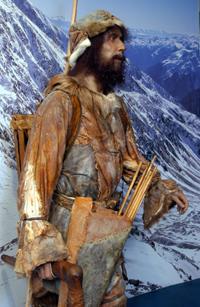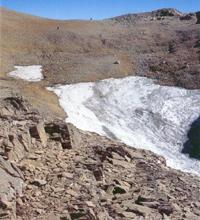Glacier melting and discovery of secrets

The first surprise was Oetzi. In 1991 a German tourist discovered the ice man in the Oetz valley, in the Italian Alps, at an altitude of 3,000 meters. That man lived in 3300 Ka. This discovery opened the hypothesis: In the Alps man lived long before what was thought.
This theory has been confirmed by the study of the discoveries made in 2003 on Mount Schnidejoch (2,756). That summer it made a terrible heat, a Swiss couple caught his attention finding a piece of wood and left Bern in the archaeological service of the canton. It was more than a piece of wood: It was a 3,000 year old buoy, that is, a container for storing and transporting arrows.
No one said anything, unlike Oetzi, they kept the information quiet. The researchers feared that the news would raise curiosity and the environment would be filled with cushions. Therefore, the findings were saved and uploaded in search of more tracks. Search and discover! They found all the equipment: leather, shoes, part of a trousers and wooden containers.
The discovery of these objects has surprised the experts. However, the most attractive results have been obtained by calculating the age of the objects. Objects belong to times when the Earth was a particularly hot place. Astrophysicist Milankovitch proposed a theory to explain Earth's climate cycles, including periods of heat and glaciations. For him, the tilt of the Earth's axis and the eccentricity of the orbit is key to understanding how warm and cold periods alternate and why glaciations occur cyclically.

In the heat, man at the top
The truth is that in hot cycles anyone could move through the high mountains, and then they are found objects. In addition, it has been proven that the glaciers of the environment in which the finding has developed are strongly influenced by climate changes.
Therefore, attendees not only report the human being who lived there, but also the climate changes. According to the researchers who have participated, they hope to obtain more detailed information on climate change in the last 6,000-7,000 years.
In this area, in addition to the goods of the Neolithic man, Roman remains have been preserved. Those of some misguided Roman have also found coins. According to experts, this was the way for the Romans to cross the Alps into Italy and northern Europe. The importance of this path was not negligible. Think that one of the coldest times on Earth, and therefore the time when the environment was to be icy, coincides in time with the decline of the Roman Empire. However, to say that the fall of the Roman Empire is a consequence of climate change is to say too much.

Leather is the key
Aside from the influence they could have on the Roman Empire, cyclical climate changes are considered proven, while scientists stress that the climate change we handle today is different. The changes Milankovitch refers to require an extremely long time, unlike the current ones. Moreover, they have used the objects to demonstrate that we are experiencing a special climate change.
The good condition of the leather parts of 5,000 years ago must be a sign of freezing. The leather easily disintegrates with rain, sun and wind. Therefore, they believe that in the last 5,000 years the glacier has never melted in 2003 and since then it has not been so good.
Published in 7K.
Buletina
Bidali zure helbide elektronikoa eta jaso asteroko buletina zure sarrera-ontzian











